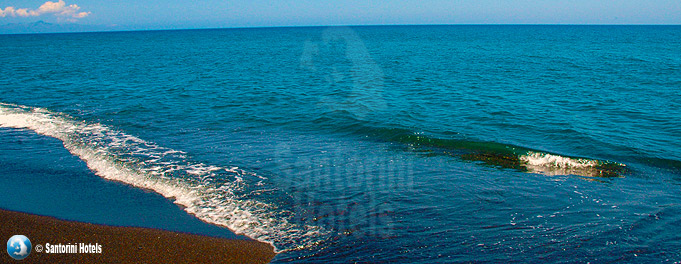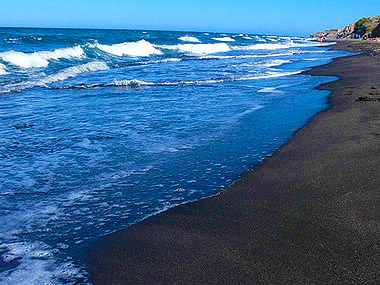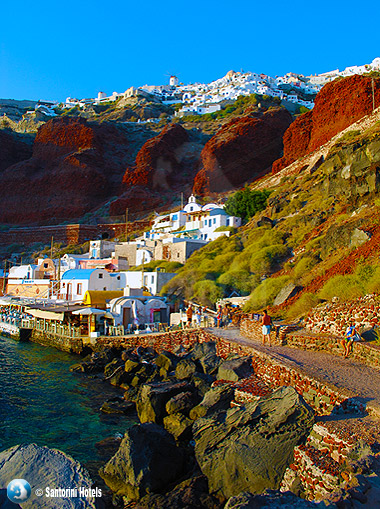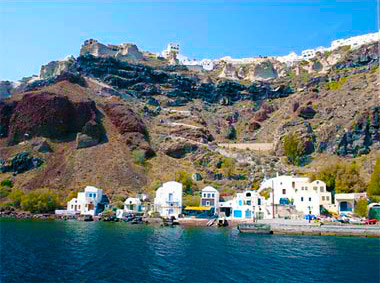 |
|
Baxedes
There are several beaches around Oia where one can swim, which can be accessed either on foot or by vehicle.
The first one is the northern Baxedes. One can go there either by bus or on foot, though it is a rather long walk. The route includes the small settlement of Tholos and several little chapels. Near the coast, on the left of Mavri Petra area, Baxedes is located. The name comes from the Turkish bahce (garden), as this is where Oians grow fruits and vegetables. There are also pezoules, horizontal surfaces separated by black stones where vines grow.
The beach has black sand, lilies like the ones depicted in the prehistoric wall paintings of Akrotiri, sandy bottom that deepens gradually and is surrounded by rocks carved in strange forms by the wind.
|

|
|
Columbus
About 10 minutes more walking among thyme and caper plants, one can meet the area of Columbus. It is signified by a large, weird grey-black rock that is hanging above the sea. The rock, where several seabirds nest, shades the beach with the black pebbles and the white seaweed. In the area around, one can also see a Hellenistic underground cemetery and the churches of St George Xechreotis and Panaghia tou Kalou (Virgin of Good).
|

|
|
Katharos
The beach of Katharos is at the west of Oia, on the right of the street that leads to Ammoudi. The path is surrounded by barren rocks of solidified lava and pumice, with gorges in-between. The church of St John Thalassinos is also on this way.
The path leads downwards, to a beach with black sand, from where one can see Therasia and the Riva beach. In the same area, Louviarika is also located; a place the lepers were sent until the Second World War.
|
|
Ammoudi
The beach of Ammoudi, which was a harbour in the 19th and early 20th centuries, can be reached in two different ways. The first one is to follow the road, passing by the now abandoned installations that were used during the excavations for collecting Theran earth. It is a downward paved road, surrounded by red rocks that seem in flames as the sunlight falls.
The second one is to follow the steps that start from Goulas. This route is called karavolades (snail), as it turns continuously, and crosses the west side of Oia, passing through hyposkapha and churches. This route can also be done on a mule. At the end of the steps, one arrives at the bay which is filled with tavernas and old warehouses. The red beach is narrow and surrounded by red rocks.
|

|
|
Aghios Nikolaos Peramataris
From here, it is easy to go to the beach of Aghios Nikolaos Peramataris. Follow the path that leads up and left and reaches the small, iron Ammoudi beacon. This path leads to some rocky beaches with deep water. However, the most impressing is a tiny islet to which one can swim.
It is ideal for divers, as the sparkling, turquoise water of the caldera hides unique underwater scenery. On the islet, the caved church of St Nikolaos Peramataris is also located. On the east side, there is a ledge, from which one can admire Oia.
|
|
Armeni
Access to Armeni bay is also from the steps in Oia. Like Ammoudi, Armeni was a harbor in the 19th-20th centuries and shipyards were found there. At the left of the beach, there is another church dedicated to St Nikolaos and a vaulted building that housed a boatshed until 1994. The beach of Armeni is tiny and sandy, with deep blue waters and two caves at the foot of the cliff.
|

|
|

